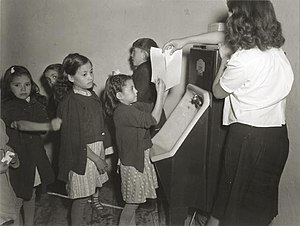
School nurses are an important—and often overlooked—part of our health care safety net. RNs at our nation’s schools handle medical emergencies, provide episodic and chronic care (including for the increasing number of children with Type II diabetes), track communicable diseases, connect children with needed insurance and health care providers, promote healthy behaviors, and screen for conditions that negatively affect learning—such as poor vision. They do all of these things mostly independently, while juggling sometimes competing and conflicting demands, rules, and laws of the educational and health care worlds. And now that Michelle Obama and the USDA have successfully added fruits and vegetables to school lunches, our school nurses are extra busy encouraging millions of school children to eat them. Some nurses must be responding to skeptical and creative students with, “No, you are probably not allergic to broccoli—only Justice Scalia is allergic to broccoli.” Given that the average school nurse in the U.S. is responsible for 1,151 students at 2.2 schools, school nurses are an important, overlooked, and overworked workforce.
Lina Rogers Struthers was the nation’s first school nurse. Part of Lillian Wald’s community nursing group, Struthers was employed by the school system of New York City in 1903. The year before she was hired a total of 10,567 children were excluded from NYC schools due to health reasons. The year after the introduction of the school nurse program only 1,101 students were excluded from school for health reasons.
On April 23, 2009 school nurse Mary Pappas in Queens, NY altered the local health department of an unusual outbreak of flu-like illness in her school. The CDC was called in to investigate and it was found to be the first documented outbreak of H1N1 influenza in the U.S., triggering a national response. This past spring in my home state of Washington, school nurse Becky Neff alerted state health officials of an outbreak of pertussis (whooping cough) in Skagit County, north of Seattle. Ms. Neff is the only registered nurse in her 3,700 student school district. (see NYT article “Cutbacks Hurt a State’s Response to Whooping Cough” 5-12-12, by Kirk Johnson) School nurses don’t just help keep students healthy: they help keep entire communities healthy. We need more of them.
Resources:
Robert Wood Johnson Foundation, Unlocking the Potential of School Nursing: Keeping Children Healthy, In School, Ready to Learn. August 2010
National Association of School Nurses (interview with Linda Davis-Aldritt, President NASN on preparation needed for being a school nurse)
CDC’s Division of Adolescent and School Health
Fun video clip about the work of Vermont school nurse Mandy Mayer, “I am a nurse, I am a leader” (won this year’s ANA award).
